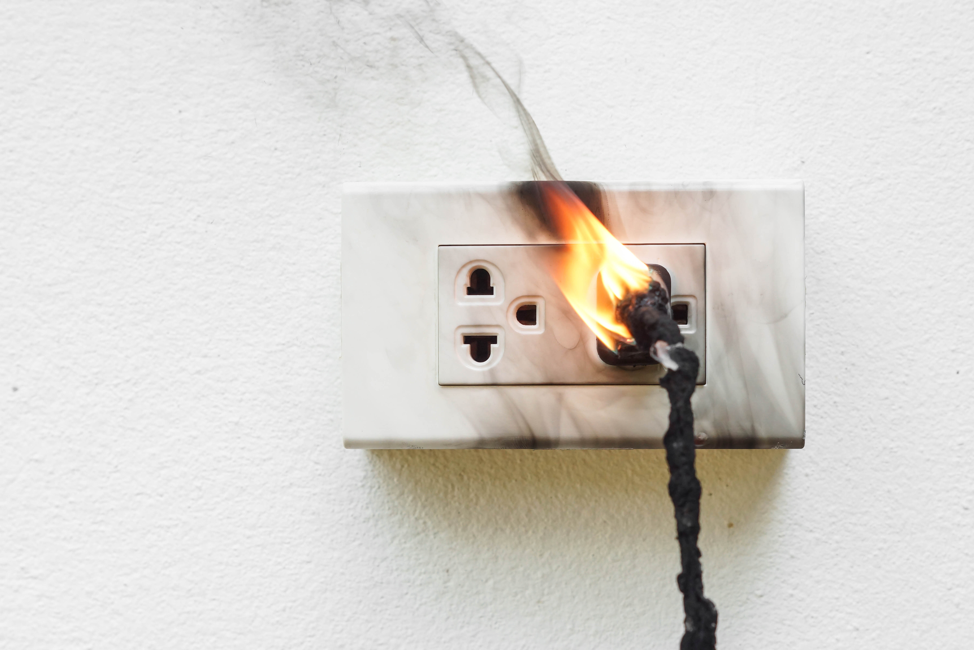Wiring for Fire and Safety Features

All homes are at risk of electrical fires. According to the National Fire Protection Association, there are about 34,000 home fires in the U.S. every year caused by electrical problems. Homes built before 1950 are at the highest risk. Electrical wiring standards weren’t as strict as they are today. An older home may support 30 amps of power compared to 100 or as much as 200 amps that present-day systems can handle. Upgrading, repairing, and spotting signs of trouble with your wiring is key to home electrical fire prevention.
The most common causes of electrical fires include incorrectly installed wiring, overloaded circuits and extensions cords, defective outlets and switches, and misuse of lighting or poor maintenance of fixtures. Defective appliances are a concern; in the past few years, millions of appliances have been recalled for this reason.
To ensure your home is safe and protected from electrical fires:
Look for Warning Signs
Flickering or dimming lights, hot outlets or switch faces, acrid plastic-like odors, or fuses that blow or circuit breakers that trip repeatedly can indicate a problem with your home wiring system. Contact our electrician in Los Angeles because damaged wiring can release arcs, which generate heat that can lead to major damage.
Be Safety Conscious
You should always have a licensed electrician to call for emergencies, make electrical modifications, and conduct inspections. A certified electrician can inspect/repair outlets; replace any outdated fuses, circuit breakers, or other components; and ensure updates comply with current building codes. Homes built between 1965 and 1973 often have aluminum wiring. Prone to oxidation, it can degrade quickly, so contact our Los Angeles electrician to inspect your wiring and replace it.
Mind Your Cords, Outlets, and Plugs
Anything that carries electric currents generates heat. Therefore, avoid running electrical cords under carpets, rugs, or bedding, or placing them across doorways or high-traffic areas. Frayed or broken cords should be thrown away. Also, don’t use extension cords as alternatives to outlets; they can easily overload. All plugs should fit tightly into an outlet; otherwise, your risk electric shock and heat damage.
Wiring Safety Tips
- Have wiring inspected by a professional if your home is over 10 years old.
- Never remove the third prong of a cable or cord; it’s there for grounding and to reduce your electric shock risk.
- Replace an appliance cord if it is damaged or looks old, worn, or frayed.
- Use cable that is properly rated; for example, plenum cables designed for use in spaces below floors and above ceilings.
- Follow all manufacturer instructions for fitting plugs and know what wire colors mean.
Avoid Quick DIY Fixes
You never want to resort to fast “short-cut” fixes. Splicing wires and reattaching them may look simple, but doing so is dangerous. Even a slight puncture can expose you to electric current that burns or shocks you or triggers an arc fault with enough heat to ignite a fire that can spread quickly. Renovation work carries a risk of damaging wires with drills, hammers, and other powerful tools.
Contact Express Electrical Services
Always consult an electrician when doing remodel work or if you suspect even the most minor of electrical problems. At Express Electrical Services, our trained Los Angeles electrician has the experience, licensure, and tools to get the job done right, and safely. We are available throughout Southern California including Los Angeles, Orange County, and Riverside County. For more information, to schedule same-day electrical service or an emergency visit 24/7, or address any electrical safety issue, call or request service online today.

Leave A Comment